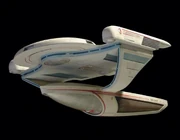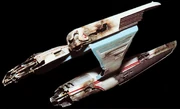m (→Physical studio models: finetuning) |
m (→Physical studio models: grm.) |
||
| Line 37: | Line 37: | ||
[[File:Oberth class studio model at Christie's.jpg|thumb|ILM's ''Oberth''-class studio model at auction]] |
[[File:Oberth class studio model at Christie's.jpg|thumb|ILM's ''Oberth''-class studio model at auction]] |
||
| − | Relabeled for a last time for {{TNG|The Pegasus}} as the {{USS|Pegasus}} [http://johneaves.wordpress.com/2011/06/10/the-uss-grissom/], subsequent appearances shot in such a way that the decals could not be discerned |
+ | Relabeled for a last time for {{TNG|The Pegasus}} as the {{USS|Pegasus}} [http://johneaves.wordpress.com/2011/06/10/the-uss-grissom/], with subsequent appearances shot in such a way that the decals could not be discerned. Very little further modification, save for some paint touch-ups (possibly to repair some minor damage after Jein took molds from it) was ever performed on the model besides relabeling. The last appearance of the model was in the [[Veridian III]] evacuation scene in {{film|7}}. The model, still labeled as the USS ''Pegasus'', was auctioned off as {{stala|1778-706|Lot #706}} on 7 October 2006, being part of the [[40 Years of Star Trek: The Collection]] auction. The estimated price for the model was $4,000 – $6,000; it sold for $18,000 ($21,600 with premium). The model was added to the collection of [http://sciencefictionarchives.com/fr/objet/219/maquette-de-luss-grissom.htm?language=EN ScienceFictionArchives.com], an European organization that is dedicated to preserve science fiction production assets for public display purposes, such as in museums. |
==The SS ''Vico'' model== |
==The SS ''Vico'' model== |
||
Revision as of 21:47, 14 December 2012
Template:Realworld

Oberth-class USS Grissom
Star Trek III: The Search for Spock, was one of the few Star Trek productions that introduced a multitude of new space faring designs at once, six in this case, including the Template:ShipClass. Though introduced in Star Trek III: The Search for Spock as the USS Grissom, a far more restraint, in comparison to the contemporary Excelsior-class studio model, has been observed when calling upon the design for repeat performances in later spin-off Star Trek productions. The design had only a limited presence in the Star Trek films, Star Trek: The Next Generation and one appearance only in Star Trek: Deep Space Nine.
Design process

Early design concept of the Oberth-class
For The Search for Spock, a unique approach to designing was adopted, not seen before or after in the Star Trek franchise. Instead of the traditional way of thinking out a design, devising a design, coming up with detailed drawings to be approved of by visual effects supervisors and building models from blueprints, this time visual artists David Carson and Nilo Rodis-Jamero of Industrial Light & Magic produced their pre-visualization artwork and handed it over to model makers Steve Gawley, Bill George and their team to be translated into study models, in essence inviting them to use their own imagination to finish up on the design. Very much a collaborative effort, Carson later remembered,"We'd churn out quite a few sketches. Then the ones that were most promising we might polish up a little in color for presentation. It wasn't uncommon for me to do a drawing that would inspire Nilo, who would then turn it into his own drawing that would be much more impressive! He would often inspire me."(Star Trek: The Magazine Volume 3, Issue 8, p. 48) Once turned over to the model makers the resulting study models were presented to producer Harve Bennett and/or director Leonard Nimoy for appraisal or as supervising model maker Gawley put it,"You had all these models sitting on a table so that the director could really get a feel for what we were talking about. It just made everything easier to understand, and insured that everybody was on the same page. It also made it easier to give cost estimates."(Star Trek: The Magazine Volume 3, Issue 8, p. 20) Director of Photography Kenneth Ralston elaborated further,"From the beginning, once Nilo Rodis, one of the visual effects art directors, had done a sketch and they got an idea of what direction to go, the model people all built prototypes. The space dock had four or five small prototypes. The Bird of Prey, I think, had only two because we all knew this one design would work and we were selling that one. The Merchant Man and the Grissom also had several designs. When Leonard and Harve and Ralph Winter came to meetings we presented them with three dimensional models. It really is a lot better doing it that way because they can physically see how different angles would work."(American Cinematographer, August/September 1984, p. 62)
The Valiant study model
One of the study models Ralston referred to was labeled as the Valiant, and was featured in the 2002 documentary, "Space Docks and Birds of Prey", disc 2 from the Star Trek III: The Search for Spock (Special Edition) DVD, already very close to the final design.
| The Valiant study model | ||
|---|---|---|

|
File:Valiant oberth temp.jpg | 
|
Photo documents reportedly taken around the time of the filming of Star Trek Generations of this Oberth-class model has led to some speculation that it was this model that was used in the evacuation scene of Veridian III. However, screencap analysis shows that the lay-out of the impulse deflector crystals as well as the lay-out of the impulse engine exhausts/transporter emitters on the nacelle deck does not correspond with the lay-out as shown on the study model. It is also highly unlikely that a study model was outfitted with an internal lighting system. It can therefore be surmised that it was in fact the original physical studio model, still wearing the USS Pegasus decals.
Physical studio models
The original studio model for the Oberth-class, built at ILM by Gawley's team, measured an overall length of 28 inches. The model first appeared in Star Trek III as the USS Grissom, and was subsequently relabeled to represent other vessels of the class. The first time the model was relabeled was for Star Trek IV: The Voyage Home as the USS Copernicus (NCC-604) as recalled by ILM's Model Shop Supervisor Jeff Mann, who has stated, "We had an incident in the beginning of the film, where we needed a Reliant-class [sic.], so we put a new paint job on the old Reliant model, changed a small shuttle [sic.] called the Grissom to the Copernicus and we added a back half to the shuttlecraft that Scotty flew around in Star Trek: The Motion Picture." (The Making of the Trek Films, 3rd ed., p. 68) Neither name or registry was ever discernible on screen, but were carried over to its next use as the SS Tsiolkovsky. It still being there was later confirmed, when TNG-Remastered was released in 2012. Michael Okuda revealed on that ocasion, "I seem to recall that Grissom may have been relabeled to serve as another ship (the Copernicus?) in Star Trek III or IV. I didn't try to relabel the model for 'The Naked Now,' partly because we realized that the existing registry would not be legible in standard-def video, but also because we were all so insanely busy at the time that no one could take on an additional project that wasn't likely to be seen on the screen." [1] The number was digitally changed to its correct one, (NCC-53911), in the first full side view establishing shot. Unfortunately, the digital artist overlooked the previous scenes and the later scene when the stellar core fragment smashes into the Tsiolkovsky, as it there still carries the original, now discernible, registry number.

|

|
Subsequently, for the television franchise, the model was relabeled trice, usually done at the art department by Okuda and later on by Doug Drexler as well, first as the USS Cochrane (NCC-59318), (stock footage of which later on used as the USS Biko), a second time as the USS Yosemite (NCC-19002). At that occasion neither name or registry was ever discernible on screen, however they could be discerned on the cover of April 1993's Cinefantastique magazine, which was devoted to Star Trek: Deep Space Nine. The cover artist, David Voight, incorporating the registry number, had an actual behind-the-scenes photograph of the studio model, dressed as the Yosemite, at his disposal as reference.

ILM's Oberth-class studio model at auction
Relabeled for a last time for TNG: "The Pegasus" as the USS Pegasus [2], with subsequent appearances shot in such a way that the decals could not be discerned. Very little further modification, save for some paint touch-ups (possibly to repair some minor damage after Jein took molds from it) was ever performed on the model besides relabeling. The last appearance of the model was in the Veridian III evacuation scene in Star Trek Generations. The model, still labeled as the USS Pegasus, was auctioned off as Lot #706 on 7 October 2006, being part of the 40 Years of Star Trek: The Collection auction. The estimated price for the model was $4,000 – $6,000; it sold for $18,000 ($21,600 with premium). The model was added to the collection of ScienceFictionArchives.com, an European organization that is dedicated to preserve science fiction production assets for public display purposes, such as in museums.
The SS Vico model

SS Vico studio model built at Gregory Jein Inc.
A second physical model was later created at Gregory Jein Inc. for TNG: "Hero Worship" to depict the severely damaged SS Vico. At the time considered too valuable to cut up the original ILM model for showcasing the damaged Vico, Jein took molds from the model and from them cast the parts to construct a new model. Co-worker Bruce MacRae helped out with detail construction and painting.[3] Jein later gave away the molds to John Eaves who actually used them to cast a solid resin model and had it gold-plated.[4] It, along with other starship models, was intended for use as a display piece in the glass cabinets in the observation lounge of the USS Enterprise-E in Star Trek Nemesis. However that fell through as Eaves delivered the models too late for use.[5] The Vico model itself, having escaped the 40 Years of Star Trek: The Collection and It's A Wrap! sale and auction auctions, is still in the possession of Paramount Pictures and has been on tour displays such as Star Trek World Tour, Star Trek: The Adventure and Star Trek The Exhibition as late as 2011.
CGI model
The last appearance of the Oberth-class was in Star Trek: First Contact in the Battle of Sector 001 scene. With the exception of the Borg cube, Borg sphere, the unnamed Nebula-class starship and the USS Enterprise-E all other ships were done as CGI models, including the at least three Oberth-class starships. Never meant to be seen up close but rather as deep background elements, the model was built at ILM by modelers Larry Tan and Paul Theren at a fairly low resolution and at a low detail level. Noteworthy was that this was the first and only time that viewers could see an Oberth-class vessel discharge it weapons. Established as an older design, the model was never used again nor was its CGI-counterpart upgraded for later appearances and the class, with the exception of the use of the physical model for DS9: "Emissary", has not been seen (though referenced to) in either Star Trek: Deep Space Nine or Star Trek: Voyager.
